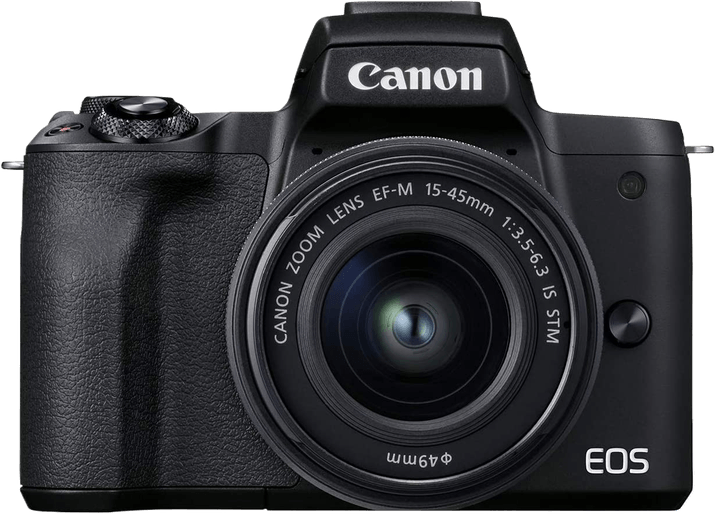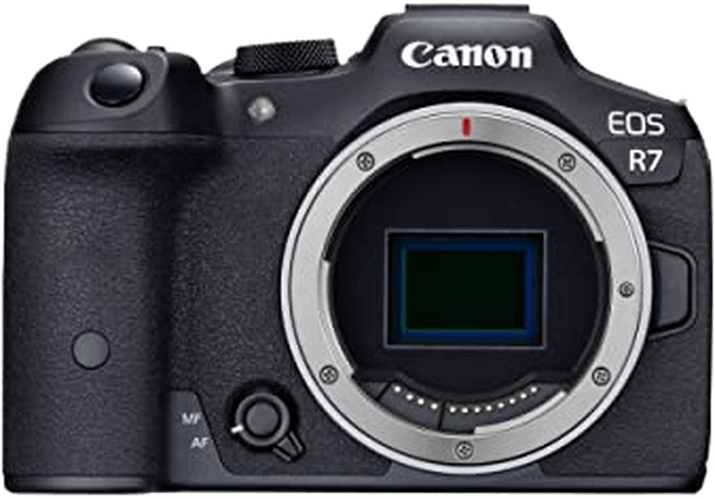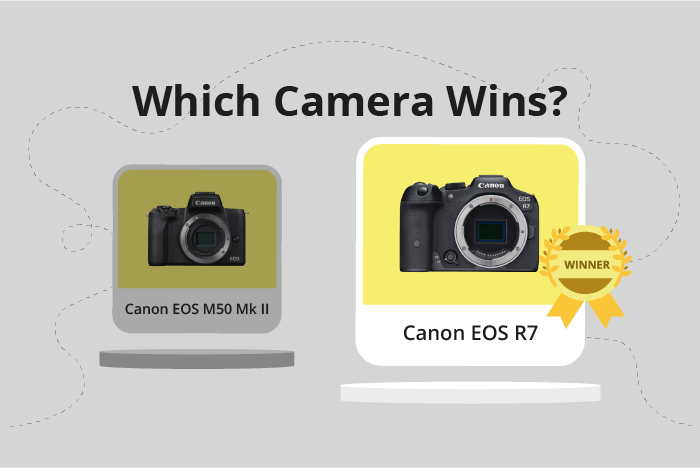Canon EOS M50 Mark II vs EOS R7 Comparison
Canon EOS M50 Mark II

Canon EOS R7

The Canon EOS R7 outperforms the Canon EOS M50 Mark II with a score of 83/100 compared to 59/100. Both cameras are mirrorless and were released in 2020 and 2022, respectively. They share similarities in size and weight, with the R7 being slightly larger and heavier at 132 x 90 x 92mm and 612g, while the M50 Mark II measures 116 x 88 x 59mm and weighs 387g.
The EOS R7’s higher score indicates its superior performance. With a launch price of $1500, it offers more advanced features and better image quality than the M50 Mark II, priced at $750. However, the M50 Mark II has its own advantages, such as being more compact and lightweight, which makes it easier to carry around.
When considering the specifications, the Canon EOS R7 is the clear winner in terms of performance, while the Canon EOS M50 Mark II may suit those looking for a more affordable and portable option.
Canon EOS M50 Mark II vs EOS R7 Overview and Optics
The Canon EOS R7 outperforms the Canon EOS M50 Mark II in optics, with a score of 82/100 compared to the M50 Mark II’s 59/100. Both cameras share several similarities in their specifications, including a CMOS sensor type, APS-C sensor size, and compatibility with Canon lenses through their respective lens mounts – the M50 Mark II with the Canon EF-M mount, and the EOS R7 with the Canon RF mount.
The EOS R7’s superior performance in optics is due to several factors. It has a higher megapixel count at 33 compared to the M50 Mark II’s 24, allowing for greater image detail and resolution. The shooting speed of the R7 is also faster at 15 frames per second, compared to the M50 Mark II’s 10 frames per second. This allows for capturing more images in a shorter amount of time, such as in action or sports photography. The R7 also benefits from a more advanced processor, the Digic X, and a significantly higher DXOMARK score for the sensor at 97, as opposed to the M50 Mark II’s Digic 8 processor and sensor score of 58. Furthermore, the EOS R7 has built-in image stabilization, which the M50 Mark II lacks.
The M50 Mark II, however, does have some advantages. Its EF-M lens mount is compatible with a wider range of lenses, providing more options for photographers. Additionally, the lower megapixel count can result in better low-light performance and faster image processing.
Considering these factors, the Canon EOS R7 is the clear winner in terms of optics, offering higher resolution images, faster shooting speeds, and better overall image quality. The M50 Mark II, while not as strong in this category, still provides versatility through its lens compatibility.
Canon EOS M50 Mark II vs EOS R7 Video Performance
The Canon EOS M50 Mark II and the Canon EOS R7 both receive a video score of 91/100, indicating that their video capabilities are on par with each other. They share several key specifications, making them equally competitive in the realm of video performance.
Both cameras possess a maximum video resolution of 4K, and their maximum video dimensions are identical at 3840 x 2160. This means that users can expect high-resolution video output from either camera. Additionally, both cameras have a maximum video frame rate of 120fps, enabling smooth and seamless motion capture for various video projects. The presence of built-in time-lapse functionality in both cameras further enhances their video capabilities, providing users with more creative options for their projects.
Although the Canon EOS M50 Mark II and the Canon EOS R7 share the same video score and specifications, it is essential to consider other factors, such as price, sensor size, and lens compatibility, to determine which camera better suits a user’s specific needs. However, based solely on video capabilities, both cameras prove to be strong contenders.
Given their identical video scores and specifications, it is difficult to declare a definitive winner between the Canon EOS M50 Mark II and the Canon EOS R7. Users must evaluate their individual requirements and preferences to determine the most suitable camera for their video projects. Regardless of their choice, both cameras offer impressive video performance that will satisfy the needs of various users.
Canon EOS M50 Mark II vs EOS R7 Features and Benefits
The Canon EOS R7 wins the features comparison with a score of 85/100, while the Canon EOS M50 Mark II scores 70/100. Both cameras share several common specifications. They both have a 3-inch touchscreen, flip screen, and lack GPS. Additionally, they come equipped with Wi-Fi and Bluetooth connectivity.
The Canon EOS R7 outperforms the Canon EOS M50 Mark II in screen resolution, offering 1,620,000 dots compared to the M50 Mark II’s 1,040,000 dots. This higher resolution provides the R7 with a sharper and clearer display, allowing for better image preview and review. This advantage makes the R7 a more suitable choice for photographers who value high-quality image preview.
On the other hand, the Canon EOS M50 Mark II has no clear advantages over the Canon EOS R7 in terms of features. Both cameras share the same screen size, flip screen, Wi-Fi, Bluetooth, and lack of GPS. This similarity in features means that the M50 Mark II does not offer any additional benefits over the R7 in this category.
Considering the higher feature score and superior screen resolution, the Canon EOS R7 is the better camera in terms of features. The M50 Mark II does not provide any significant advantages over the R7, making the R7 the more appealing choice for photographers seeking a camera with excellent features.
Canon EOS M50 Mark II vs EOS R7 Storage and Battery
The Canon EOS R7 outperforms the Canon EOS M50 Mark II in storage and battery with a score of 79/100, compared to the M50 Mark II’s 21/100. Both cameras accept SD, SDHC, and SDXC memory cards. However, the R7 is UHS-II compatible, while the M50 Mark II is only UHS-I compatible.
The R7 surpasses the M50 Mark II with two memory card slots, doubling storage capacity. Additionally, the R7 has a longer battery life of 660 shots, compared to the M50 Mark II’s 305 shots. The R7 uses the LP-E6NH battery type and offers USB charging, making it more convenient for on-the-go use.
On the other hand, the M50 Mark II has a limited advantage in storage and battery. It has only one memory card slot and a shorter battery life of 305 shots, using the LP-E12 battery type. Furthermore, it lacks USB charging capabilities.
Considering these points, the Canon EOS R7 clearly excels in storage and battery performance, offering more memory card slots, better compatibility, longer battery life, and USB charging. This makes it a superior choice for photographers seeking convenience and extended shooting capabilities.
Canon EOS M50 Mark II vs EOS R7 – Our Verdict
Are you still undecided about which camera is right for you? Have a look at these popular comparisons that feature the Canon EOS M50 Mark II or the Canon EOS R7:

